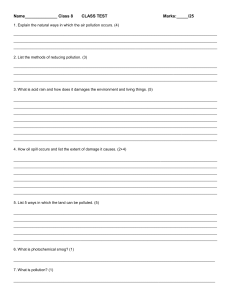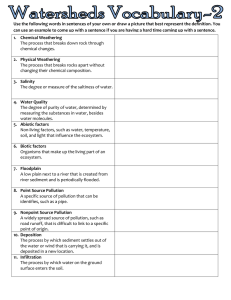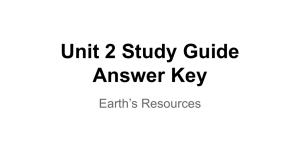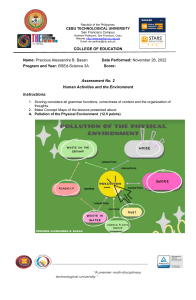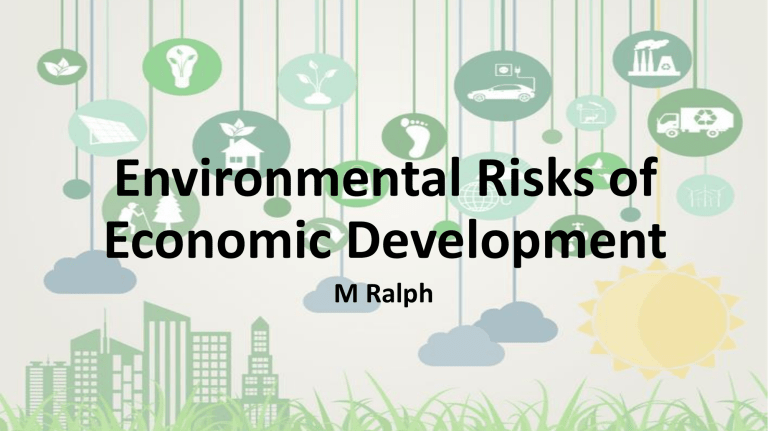
Environmental Risks of Economic Development M Ralph Topic Outline • How can economic activities pose threats to the natural environment, locally and globally? • How important is sustainable development and management to the overall economic development of an area? • How important is Resource conservation? Starter! Copyright - M Ralph O'Mahony Learning Objectives All – List different types of Pollution Most – describe the environmental impacts of the different types of pollution Some – Evaluate the long-term and short-term impacts of pollution for an area you have studied. Extension – Research and write up a case study on a local and global impact of Pollution Copyright - M Ralph O'Mahony Humans Vs Earth • Many people live in environments where it is easy to survive e.g. Ireland has a mild climate and good farm land so people can grow plenty of food • Not everyone lives in a mild climate (Tundra/Deserts) some people have a constant struggle to find water and food. But we are a very adaptable species. • Places that seem to have little opportunity for people have settlements (Al Ain, UAE – the middle of the Arabian Desert) • Most densely populated areas of the world have natural environments that have all the basics (water, food, fuel & shelter) Good Living Links To Getting More From The Land! By having access to a good place to live, it enables people to carry out other activities to make a living and help a country to develop! • Low, flat land with deep, fertile soils • Reliable source of fresh water • No extreme climate and a long growing season • Natural vegetation (forest or grassland) • Natural resources, (energy supplies and mineral resources) • Natural Beauty that is attractive to tourists Lack of natural resources, especially Fresh Water Unattractive or desolate Scenery Characteristics of Harsh Environments High, Steep Land Natural Vegetation which is desert, poor grassland or dense forest Thin, Dry and Easily eroded soils Extreme Climate Rocky, Bare Landscape Research Activity 1. Research the area where you live, make a list of the problems and opportunities are available in you area (temperature, tourism, energy) 2. Which areas of where you live have few people living there because of the natural environment? List possible opportunities that may be available in this area 3. Look at the list of basic needs found in your area (water, fuel, food and shelter) which is most important and least important and explain why? 4. Choose an economic activity (agriculture/ tourism etc.) what features of the natural environment are most useful for this type of economic activity What is Pollution? Pollution is the presence in or introduction into the environment of a substance which has harmful or poisonous effects • There are 2 main categories of pollution: Incidental Pollution typically caused by a one off disaster e.g. and oil spill and Sustained Pollution which is persistent long term pollution typically caused by factories • Some of the main types of Pollution are as follows: Water Pollution, Air Pollution, Land Pollution, Thermal Pollution, Radioactive Pollution, Noise Pollution and Light Pollution Research Task! Using the list of the different types of pollution below, create detailed notes on the different types, the source of the pollution and the different types of damage they cause • Water Pollution. • Air Pollution. • Land Pollution. • Thermal Pollution. • Radioactive Pollution. • Noise Pollution. • Light Pollution Starter! Copyright - M Ralph O'Mahony Learning Objectives All – List different economic activities that may cause a threat to the natural environment Most – describe how soil erosion can have long term consequences for the environment Some – Explain how soil erosion occurs Extension – Research and write up a case study on a local and global impact of soil Erosion Copyright - M Ralph O'Mahony It’s getting hot in here! • Global Warming: is the increase in global temperature over the last century • Climate Change: is any change in the weather over a long period of time • The Green House Effect: The greenhouse effect is defined as when the Earth's atmosphere becomes thick with gases and substances which trap the sun's radiation, making the Earth warmer. Evidence of Climate Change • The earths average temperature has been stable at approx. 14°C since the last ice age. However recently there has been a steady increase in global temperatures. • Evidence of this can be seen in Higher temperatures, changing rainfall patterns, melting sea ice and melting glaciers and ice sheets, rising Sea levels and even the changing of the seasons. Melting Polar Ice Caps, Ice sheets (in countries like Greenland) and glaciers could cause sea levels to rise up to 5 meters (a severe problem for the 40% of the worlds population who live close to the coast! Rising sea temperatures will mean the oceans expand, leading to an average worldwide sea level rise of 40cm by 2100 – this would mean widespread flooding of low lying areas. Changes to farming as equatorial areas become too hot and tropical crops are grown further north. There could be changes in extreme weather events, e.g. temperatures over 40°C causing wildfires in Australia, more hurricanes in the Caribbean, deadly heatwaves in Europe and Floods in Egypt. The Effects of Climate Change The coral reefs that provide many countries (Belize, Australia etc. ) with a big tourist attraction could die! Wars may be fought as the global population grows and precious resources such as food and water become scarce in some countries. Tropical diseases become more widespread – malaria, for instance, could become common in Europe! Extinction of wildlife that is unable to adapt to the changing climate – some scientists estimate up to 1/3 of all species could become extinct over the next 100 years. Video Clip! What is soil? The upper layer of earth in which plants grow, a black or dark brown material typically consisting of a mixture of organic remains, clay, and rock particles Why is soil so important? •It is one of the most important natural recourses we depend on •We use it for building, to farm, to grow our food the list is endless Can you think of other uses for soil? Why is it so important for us to look after soil? Soil Erosion and Desertification • Soil Erosion: Soil erosion is defined as the wearing away of topsoil. Topsoil is the top layer of soil and is the most fertile because it contains the most organic, nutrient-rich materials • Soil Degradation: Soil degradation is the decline in soil condition caused by its improper use or poor management, usually for agricultural, industrial or urban purposes. It is a serious environmental problem • Desertification: the process by which fertile land becomes desert, typically as a result of drought, deforestation, or inappropriate agriculture. Desertification! Desertification is when a desert gradually spreads to the surrounding areas of semi desert, making them true desert (unsuitable for farming). Human activity is usually one of the main causes of desertification Wildlife – chased away or forced to leave as natural habitats are destroyed Soils – growing the same crops year after year reduces soil fertility and chemical fertilisers need to be added in larger amounts Natural vegetation chopped down to make way for fields to grow crops or bio fuels Damage caused by Agriculture Physical landscape – hills are terraced and the landscape destroyed to increase land available for growing crops Rivers Seas and Lakes – chemicals in fertilisers and pesticides can be washed into the watercourse Atmosphere – farm machinery pumps pollutants into the air while rotting vegetation adds dangerous methane to the atmosphere Video Clip! 3 main Causes of Desertification •Increased Population •Climate Fluctuations •Commercial Agriculture Farming can cause Soil Erosion! • Ploughing - compacts the ground and creates channels for rapid water flow, especially on slopes. • Deforestation – removes roots holding soil and allows extensive wind and water damage • Monoculture – the use of chemical fertilisers (soil cant recover naturally) • Removal of hedgerows – makes soil vulnerable to soil erosion • Overgrazing – vegetation is removed faster than it can grow How can we STOP soil erosion? •Terracing •Shelter Belts •Contour Ploughing •Strip Farming •Leave Stubble •Stone Lines Starter! Copyright - M Ralph O'Mahony Learning Objectives All – List different types of sustainable development Most – describe the importance of sustainable development in order to maintain a good quality of life for future generations Some – Explain the challenges that face the world in becoming more sustainable use a case study to explain your answer. Extension – Research and write up a case study on a areas effort to become more sustainable Copyright - M Ralph O'Mahony Sustainable Development What is development? Development refers to the changes and improvements in the standard of living and its quality of life of its human inhabitants. What is Sustainable Development? Sustainable development is development that meets the needs of the present without compromising the ability of future generations to meet their own needs in terms of the environment, economy and society. Video Clip! Team Task! 1.Green Spaces 2.Forrest Protection /Replanting 3.Efficient Water Fixtures 4.Wind Energy 5.Solar Energy 6.Crop Rotation Exploiting the Natural Environment The Aral Sea Disaster! • Location: the border of Kazakhstan and Uzbekistan • Area before 1965: 65,300 KM² • It was the worlds 4th largest lake and was fed by 2 rivers (The Amu Darya and the Syr Darya) • Climate: Arid with high summer temp often reaching 50°C winters are cold with very low rainfall. The Aral Sea Disaster • Due to the lack of rainfall agriculture is very difficult in the area, meaning that the majority of people made a living by fishing in the sea. • In the 60s thousands of fisher men trawled over 40,000 tonnes of fish a year were fished frim the Aral Sea. • Many more people were employed in industries that supported the fishing in nearby towns. The start of the Problems in the Aral Sea! • In the 1960s Kazakhstan and Uzbekistan were still part of the Soviet Union, the government decided to use the water in the Amu Darya River to grow wheat and cotton. • Huge canals were built to divert water through irrigation channels to help water the crops. • This was disastrous for the Aral Sea, because less water was reaching the lake it began to dry up and shrink. • By 1989 it had shrunk to half its original size. Impacts on the People and the Environment of the Aral Sea! • Fishing became extremely difficult, the water was further away from the towns where people lived. • They tried to solve the problem by building Canals to allow ships to get to the lake, however the ships eventually had to be abandoned due to the fact that the water levels had fallen so drastically! • As the water level dropped the salinity increased until it became almost as salty as the oceans, most of the remaining fish died and the fishermen had to move away to find jobs elsewhere. Impacts on the People and the Environment of the Aral Sea! • Environmental damage was caused by agricultural fertilisers and pesticides needed for intensive farming of wheat and cotton, this polluted both drinking water and the water used to irrigate the crops. • Summers got hotter and winters got cooler at the decrease in water affected the climate. • Violent dust storms blew salt, sand and chemicals into the air and people developed throat cancers and breathing diseases, including tuberculosis. • With no protein from fish people suffered from malnutrition and the number of children dying increased to become the highest rate in the soviet union. Video Clip! Further Research! • The Great Barrier Reef, Australia. • Deforestation in Borneo. • Abandoning the Carteret Islands. • Greenland – the biggest Island in the world. • Chernobyl, Nuclear Disaster 1986. • Bhopal Chemical Factory, India. • China’s Pearl River Delta.

